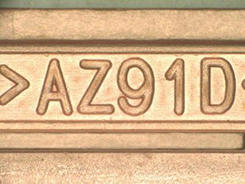Magnesium, showing the least noble potential among practical metals, corrodes most easily, but because it is ultra-lightweight and excellent in recyclability, its use has been rapidly expanding for cases of PCs, cell phones, etc., and in the field of transportation equipment in recent years. Magnesium alloys are mainly AZ-based and AM-based, the alloy constituents of which are aluminum (A), zinc (Z), and manganese (M); and ZK-based with the alloy constituent of zirconium (Z). In order to improve anticorrosive performance, which is the greatest disadvantage, anode oxidation, chemical conversion treatment, plating, coating, and so on are provided industrially.
| Type | Characteristic value | Uses |
|---|---|---|
| AZ 31 | [Chemical composition] Aluminum (Al) 3% Zinc (Zn) 1% Manganese (Mn) 0.3% Magnesium (Mg) remainder [Mechanical properties] Tensile strength 250MPa (25kgf/mm2) Elongation 7% |
- Automotive parts - Electronic information communication equipment, such as PCs, cell phones, TVs, video cameras, etc. - Other industrial parts, such as sports gear, aircraft, welfare and nursing equipment, etc. |
| AZ91 | [Chemical composition] Aluminum (Al) 9% Zinc (Zn) 0.7% Manganese (Mn) 0.3% Magnesium (Mg) remainder [Mechanical properties] Tensile strength 275MPa (27.5kgf/mm2) Elongation 15% |

Copper plating for magnesium alloy (AZ91)
Types of plating